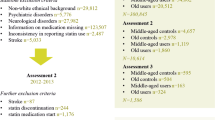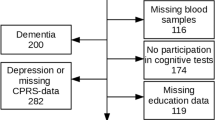Abstract
Objective
This study was undertaken to assess the effects of atorvastatin on cognition and higher mental functions.
Methods
In this before and after comparison study with controls, group one included 55 subjects aged ≥40 years requiring statins for cardiovascular indications who were started on atorvastatin (10 mg/day). Group two assigned to receive placebo were men and women chosen from the same geographical area and matched for age, sex, education and presence of hypertension and diabetes mellitus. Assessment was done with the Mini-Mental State Examination, Digit Span, Picture Test (average and delayed), Trail Making Test, Controlled Oral Word Association Test, Digit Symbol Substitution Test and Auditory Vigilance and Digit Vigilance Test at baseline and after 6 months. Changes between baseline and 6 months in the above parameters of mental function were compared using suitable statistical tests in the atorvastatin and placebo groups. To limit experiment-wise error, performance scores were grouped into five cognitive domains, which were labeled as attention, psychomotor speed, mental flexibility, working memory and memory retrieval. Summary effect sizes were estimated as z-scores.
Results
Both subjects on atorvastatin and placebo showed improvement in the majority of scales consistent with a learning effect on test performance. However, subjects treated with atorvastatin scored significantly over the placebo group in all domains, i.e. tests of attention [z-score=0.54, 95% confidence interval (CI): 0.38–0.64, p=0.001], psychomotor speed (z-score=0.28, 95% CI: O.09–0.47, p<0.001), mental flexibility (z-score=0.27, 95% CI: 0.22–0.32, p=0.01), working memory (z-score=1.22, 95% CI: 0.93–1.50, p<0.001) and memory retrieval (z-score=0.59, 95% CI: 0.36–0.82, p<0.05).
Conclusion
The present study concludes that there are significant beneficial effects of atorvastatin in a dose of 10 mg/day for a period of 6 months on higher functions as measured by the above standard neurocognitive tests.
Similar content being viewed by others
References
Beatrice A, Golomb MH (2004) Conceptual foundations of UCSD Statin Study. Arch Int Med 164:153–162
Benton D (1995) Do cholesterol levels slow mental processing? Psychosom Med 57:50–53
Cattin L, Bordin P, Fonda M et al (1997) Factors associated with cognitive impairment among older Italian inpatients. J Am Geriatr Soc 45:1324–1330
Cutler N, Sramek J, Veroff A, Block G, Stauffer L, Lines C (1995) Effects of treatment with simvastatin and pravastatin on cognitive function in patients with hypercholesterolemia. Br J Clin Pharmacol 39:333–336
Davidson MH (2001) Safety profiles for the HMG Co-A reductase inhibitors: treatment and trust. Drugs 61:197–206
Dales MJM (2000) Statination. Intern Med News 1:55–56
Dietschy JM, Turley SD (2001) Cholesterol metabolism in the brain. Curr Opin Lipidol 12:105–112
England JD, Viles A, Walsh JC, Stewart PM (1999) Muscle side effects associated with simvastatin therapy. Med J Aust 153:562–563
Fassbender K, Simons M, Bergmann C, Stroick M et al (2001) Simvastatin strongly reduces levels of Alzheimer’s disease beta-amyloid peptides Abeta42 and Abeta 40 in vitro and in vivo. Proc Natl Acad Sci USA 98:5856–5861
Folstein MF, Folstein SE, McHugh PR (1975) “Mini-mental state". A practical method for grading the cognitive state of patients for the clinician. J Psychiatr Res 12:189–198
Friedewald WT, Levy RI, Friedrickson DS (1972) Estimation of the concentration of low-density lipoprotein cholesterol in plasma without use of the preparative ultracentrifuge. Clin Chem 18(6)499–502
Golomb BA (1998) Cholesterol and violence: is there a connection? Ann Intern Med 128:478–487
Grobbee ED, Bots LM (2003) Statin treatment and progression of atherosclerotic plaque burden. Drugs 63(9):893–911
Hajjar I, Schumpert J, Hirth V, Wieland D, Eleazer GP (2002) The impact of the use of statins on the prevalence of dementia and the progression of cognitive impairment. J Gerontol A Biol Sci Med Sci 57(7):M414–M418
Harrison RWS, Ashton CH (1994) Do cholesterol-lowering agents affect brain activity? A comparison of simvastatin, pravastatin, and placebo in healthy volunteers. Br J Clin Pharmacol 37(3):231–236
Houx PJ, Shepherd J, Blauw GJ et al (2002) Testing cognitive function in elderly populations: the PROSPER study. PROspective Study of Pravastatin in the Elderly at Risk. J Neurol Neurosurg Psychiatry 73(4):385–389
Jick H, Zornberg GL, Jick SS, Seshadri S, Drachman DA (2000) Statins and the risk of dementia. Lancet 356(9242):1627–1631
King DS, Wilburn AJ, Wofford MR et al (2003) Cognitive impairment associated with atorvastatin and simvastatin. Pharmacotherapy 23(12):1663–1667
Kojro E, Gimpl G, Lammich S, Marz W, Fahrenholz F (2001) Low cholesterol stimulates the nonamyloidogenic pathway by its effect on the alpha-secretase ADAM10. Proc Natl Acad Sci USA 98:5815–5820
Krysiak R, Okopie B, Herman SZ (2003) Statin treatment and progression of atherosclerotic plaque burden. Drugs 63(9):893–911
Laufs U, Bohm M, Gertz K et al (2002) The hydrophilic HMG-CoA reductase inhibitor rosuvastatin regulates endothelial NO synthase and ischaemic stroke in vivo. Circulation 106(19 suppl):I272
Lewis RF, Rennick PM (1979) Manual for repeatable cognitive perceptual motor battery. Axon, Clinton, MI
Mason RP, Herbette LG, Silverman DI (1991) Can altering serum cholesterol affect neurologic functions? J Mol Cell Cardiol 23:1339–1342
Muldoon MF, Barger SD, Ryan CM et al (2000) Effects of lovastatin on cognitive function and psychological well-being. Am J Med 108:538–546
Muldoon MF, Flory JD, Ryan CM (2000) Serum cholesterol, the brain and cognitive functioning. In: Waldstein SR, Elias MF (eds) Neuropsychology of cardiovascular disease. Lawrence Erlbaum Associates, Mahwah, NJ
Nangle MR, Cotter MA, Cameron NE (2003) Effects of rosuvastatin on nitric oxide-dependent function in aorta and corpora cavernosum of diabetic mice: relationship to cholesterol biosynthesis pathway inhibition and lipid lowering. Diabetes 52(9):2396–2402
Orsi A, Sherman O, Woldeselassie Z (2001) Simvastatin-associated memory loss. Pharmacotherapy 21(6):767–769
Raggat JL, Partridge CN (2002) HMG CoA reductase inhibitors as immunomodulators: potential use in transplant rejection. Drugs 62(15):2185–2191
Reitan RM, Wolfson D (1993) The Halstead-Reitan neuropsychological test battery. Theory and clinical interpretation, 2nd edn. Neuropsychological Press, Tucson AZ
Rockwood K, Kirkland S, Hogan DB, MacKnight C, Merry H, Verreault R, Wolfson C (2002) Use of lipid-lowering agents, indication bias, and the risk of dementia in community-dwelling elderly. Arch Neurol 59(2):223–227
Rose GA, Blackburn H, Gillum RF, Prineas RJ (1982) Cardiovascular survey methods, 2nd edn. (WHO Monograph Series no. 56 vol 1) WHO, Geneva
Waldstein SR, Jennings, JR, Ryan CM et al (1996) Hypertension and neuropsychological performance in man: interactive effects of age. Health Psychol 15:102–109
Ryman A (1994) Cholesterol, violent death and mental disorder. BMJ 309:421–422
Shepherd J, Blauw GJ, Murphy MB et al (2002) Pravastatin in elderly individuals at risk of vascular disease (PROSPER): a randomised controlled trial. Lancet 360:1623–1630
Simons M, Schwarzler F, Lutjohann D et al (2002) Treatment with simvastatin in normocholesterolemic patients with Alzheimer’s disease: a 26-week randomized, placebo-controlled, double-blind trial. Ann Neurol 52:346–350
Sparks DL, Connor DJ, Browne PJ et al (2002) HMG-CoA reductase inhibitors (statins) in the treatment of Alzheimer’s disease and why it would be ill-advised to use one that crosses the blood-brain barrier. J Nutr Health Aging 6:323–324
Spreen O, Strauss E (1991) A compendium of neuropsychological tests. Administration, norms, and commentary. Oxford University Press, New York
Stalker TJ, Lefer AM, Scalia R (2001) A new HMG-CoA reductase inhibitor, rosuvastatin, exerts anti-inflammatory effects on the microvasculature endothelium: the role of mevalonic acid. Br J Pharmacol 133(3):406–412
Wagstaff LR, Mitton MW, Arvik BM et al (2003) Statin-associated memory loss: analysis of 60 case reports and review of the literature. Pharmacotherapy 23(7):871–880
Wechsler D (1997) Wechsler Adult Intelligence Scale, 3rd edn. Psychological Corporation, San Antonio, TX
Wehr H, Parnowski T, Puzynski S et al (1996) Apolipoprotein E genotype and lipid and lipoprotein levels in dementia. Age Ageing 15:267–270
Wolozin B, Kellman W, Rousseau P, Celesia GG, Siegel G (2000) Decreased prevalence of Alzheimer disease associated with 3–hydroxy–3–methylglutaryl coenzyme A reductase inhibitors. Arch Neurol 57:1439–1443
Yaffe K, Barrett–Connor E, Lin F, Grady D (2002) Serum lipoprotein levels, statin use, and cognitive function in older women. Arch Neurol 59(3):378–384
Author information
Authors and Affiliations
Corresponding author
Rights and permissions
About this article
Cite this article
Parale, G.P., Baheti, N.N., Kulkarni, P.M. et al. Effects of atorvastatin on higher functions. Eur J Clin Pharmacol 62, 259–265 (2006). https://doi.org/10.1007/s00228-005-0073-z
Received:
Accepted:
Published:
Issue Date:
DOI: https://doi.org/10.1007/s00228-005-0073-z




